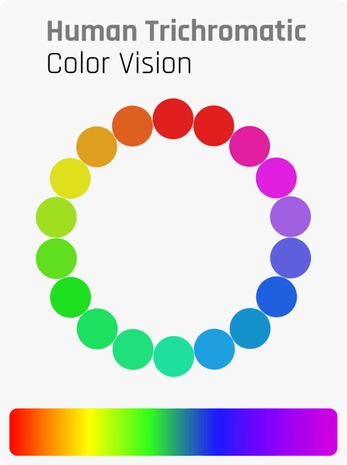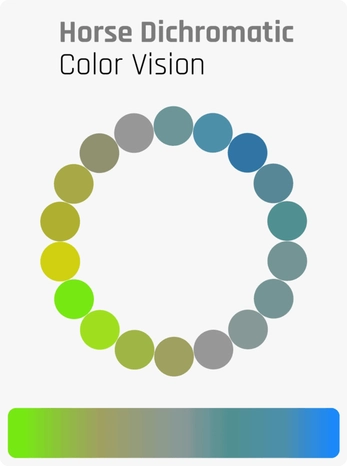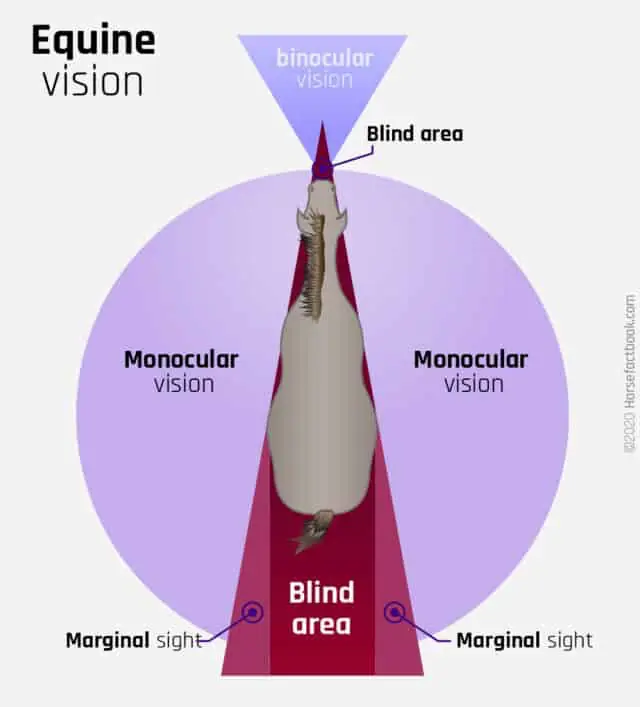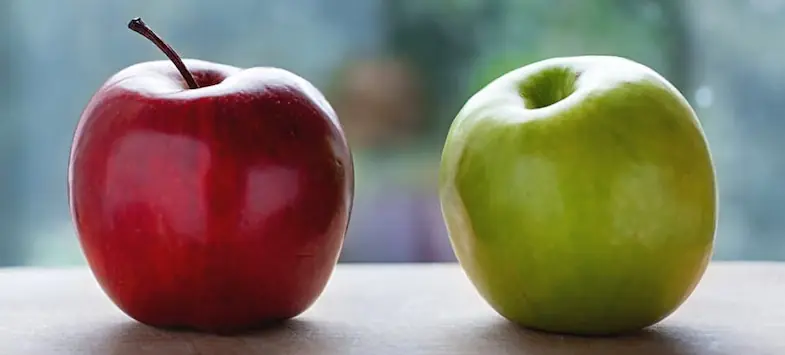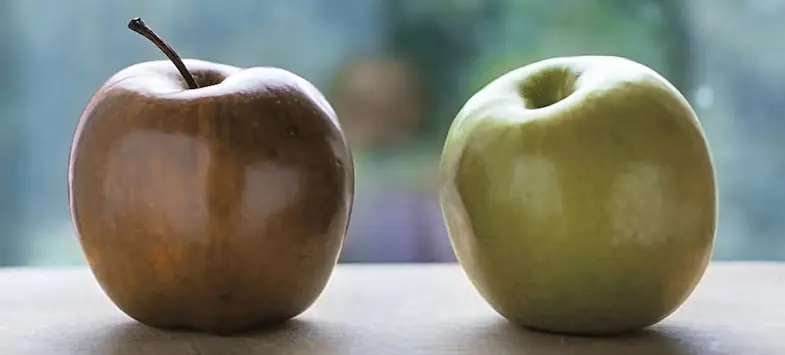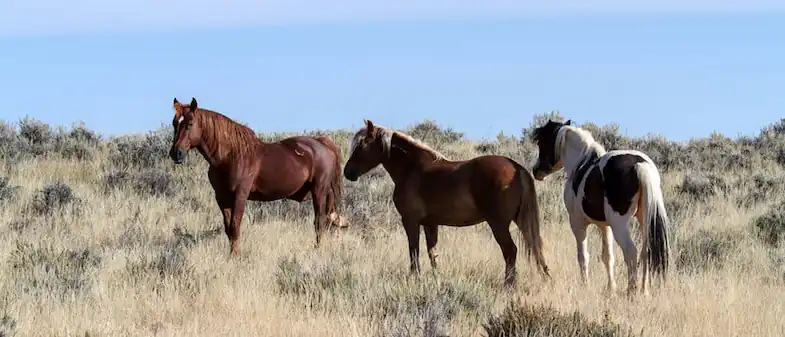There are lots of different myths about how a horse’s vision works and what they can and can’t see, some people will argue that they don’t have depth perception while others will insist that they can only see in black and white. While we’re still a long way off of fully understanding how a horse’s eye works we’ve come a long way in our awareness of how they see the world.
Horse field of view and depth perception
Horses are prey animals so as you can imagine they have exceptional vision and almost have a 360-degree field of view with just a 5-degree blind spot right in front of them and another 5-degree spot directly behind them. You might think that these blind spots could present a problem but with a subtle tilt of the head, the horse can see perfectly.
This really wide field of view is actually why race and carriage horses often wear blinders. Blinders help limit horses’ field of view so they can just focus on what’s in front of them so they don’t get distracted or spooked. This article that I wrote has a lot more information about horse blinders, when they’re used, and how they can help reduce a horse’s stress.
Over time horses’ eyesight has developed to help keep them alive and safe from predators. This means that while they do have limited color vision, contrary to popular belief, they do actually have excellent depth perception except for the areas in their blind spots.
How does a horse’s vision work?
Like so many other prey mammals, horses’ eyes are positioned laterally which means they’re on the side of their head instead of on the front (like ours are). This helps to give them a better, and wider, field of vision so they’re able to spot any possible danger and react long before it arrives. That doesn’t mean that they can’t see objects that are close to them though.
As is the case with most animal’s eyes, with the exception of the skate (the only animal that can’t see color), a horse’s eye is made up of rods and cones that help them to see in low light as well as much higher light levels but that is only part of how a horse’s vision works.
- Rods – Responsible for an animal’s perception of light (or scotopic vision), they allow horses to see in low light.
- Cones – Responsible for controlling an animal’s photopic vision. Horses have two different types of cones that control the colors they can see; short-wavelength (blue), middle wavelength (green). There’s also a long-wavelength cone (present in humans) that allows you to see red but horses don’t have long-wavelength cones.
As well as seeing in a range of light conditions horses actually have two forms of vision and can easily switch between the two, but they do also have small blind spots.
Monocular Vision in Horses
This is where both eyes can be used separately at the same time. It allows the horse to have a wide field of view (almost 360°) although it does limit their perception of depth. Due to the position of a horse’s eyes, even with monocular vision, they have two blind spots; one right in front of them and the other directly behind. Monocular vision allows the horse to see any approaching threats, regardless of the direction they’re coming from.
Binocular Vision in Horses
Similar to how our eyes work, binocular vision allows horses to see directly in front of them with both of their eyes, although they do still have a 3ft (0.9 meters) to 4ft (1.2 meters) blind spot right in front of them. Binocular vision gives the horse the ability to judge distances as well as to focus on objects in front of them.
Horse Blind spots
The monocular and binocular visions combine to give the horse an unparalleled field of view but, because of where the eyes are positioned, they do have blind spots. They have two main spots but also a small region where they only have marginal vision. A horse’s vision runs down his nose and slightly above the level of his eyes, with the blind spot being approximately the width of his body. This is why it’s so important to not have too tight a rein and allow your horse the freedom to move his head while riding. If he’s ridden on the bit (with his forehead vertical to the ground) or behind the bit ( with his nose pointing towards his chest) he’ll only be able to see the dirt below his nose.
From a young age, I learned never to approach a horse from directly behind. After learning that a horse can see almost 360 degrees, but not what’s directly behind them, it makes sense that a horse would spook easily if approached from behind. This reaction makes it much harder for a horse that has vision trouble. That’s why if you have a horse that spooks easily or rears up often, its vision may be the reason. I’ve written more about horse rearing and the usual causes in this article.
Can horses see in the dark?
Some horses will hesitate when you ask them to ride into a dark area which is why people will argue that they can’t see in the dark but this isn’t due to the horse’s inability to see in the dark, after all, they eat enough carrots so should have great night vision!
If you’ve ever watched horses in the field at night (or called them in in the dark) you’ll notice how they can move around without tripping over or bumping into anything, regardless of their speed, if they had poor night vision this just wouldn’t be the case and, let’s be honest, they wouldn’t be able to graze in the dark either.
At the back of a horse’s eye is a membrane known as the tapetum lucidum which is a retroreflector meaning it reflects visible light back through the retina, increasing the amount of light in the eye and therefore a horse’s ability to see in the dark, this and the high number of rods (the part of the eye that controls night vision). So the truth is horses actually have very good night vision, but where they do struggle is with quick changes in light. This is why some horses hesitate before entering a dark area, the same is true for sudden increases in light; it only takes a few seconds for their vision to adapt but it’s those few seconds that, in the wild at least, can literally be the difference between life and death.
Of course, horses can’t see as well in the dark as say an owl can but that doesn’t mean their vision is poor.
Do horses see color?
Anybody who’s seen a horse shy away from a particular color will tell you that horses can most definitely see color but that doesn’t mean they see color in the same way that we do. The color an eye sees depends on the wavelengths of the cones (short, middle, and long) it has and while we have all three cone wavelengths (known as trichromatic, this allows us to see the full spectrum of red, green, and blue), horses only have two (known as dichromatic) allowing them to see only blue and green, although their middle wavelength cones can see a fraction of red. It’s thought that the reason for this is because when horses first evolved they were more active at dawn and dusk when there’s little need to be able to see red.
Horses do have color deficiencies which make some objects harder to see but not completely invisible. This is one of the reasons why many jumps are painted in bright contrasting colors and evidence certainly backs this up as horses are less likely to knock a fence down if it’s painted in contrasting colors.
Can horses see 360 degrees?
Like many predated animals that spend a lot of time grazing, horses have a very wide range of vision but they don’t quite have a full 360 field of view (even owls don’t have that without rotating their heads). Horses have the largest eyes amongst all land mammals which gives them a wider viewing range than most other animals, allowing them to have a 350-degree range with their monocular vision, even without moving their head at all. There are only two places that a horse can’t see without moving, straight in front of them and right behind them, although they do have a small area of marginal sight on either side of their rear blind spot.
While a horse’s binocular vision won’t improve their viewing range it does give them the ability to see straight in front of them, albeit with a very small (3ft to 4ft / 0.9 meters to 1.2 meters) invisible spot.
Do horses have good depth perception?
It’s a long-held myth that, because horses have their eyes on the side of their head, they’re not able to judge distances very well which gives them poor depth perception but this isn’t the case. Yes, there is a moment when a horse approaching an obstacle won’t see it so he’s effectively jumping blind but this is only for a very short period of time.
With just one eye a horse can adequately judge depth, in part because their eyes are positioned slightly further forward which gives them a slight overlap of approximately 55° to 65°. With a tiny movement of the head (ie raising, lowering, or tilting) though they can see into their blind spots, improving their depth perception. This is, of course, with monocular vision, when they use their binocular vision their depth perception is excellent.
Want to know more?
If you want to know more about how horses see as well as how they interpret the world around them then you might be interested in these articles.
What do horses think if you look them directly in the eye?
How do you care for a blind horse?
Myth-busting
There are a lot of myths about how horses see but most of these come from our lack of understanding about how their eyes work and how they see the world.
Horses are nearsighted
People argue that horses are nearsighted and can’t see objects that are far away but this simply isn’t true, after all, horses wouldn’t have survived as long as they have if they couldn’t see approaching danger until it was too late to react. Research carried out by Carol Hall, Ph.D. of Nottingham Trent University shows that while around a third of domestic horses are nearsighted most are actually farsighted, although there can be differences between breeds, you can read the study here. It’s also worth noting though that all wild horses are farsighted.
Horses need to see things from both the left and the right side
All mammals have a structure in their brain, called the corpus callosum, that connects both the left and right hemispheres of the brain and allows information to be shared between both sides. This is most evident in the research carried out by Dr. Hanggi and the Equine Research Foundation. They ran a series of tests, on a number of horses, to demonstrate that one eye can see something that both sides of the brain can understand. The research, which can be read here, involved horses (that had one eye blindfolded) being shown images they’d ever seen before, they were then encouraged to touch one of the pictures for food. The blindfold was then moved to the other eye and the test was repeated, with every single horse touching the same image they had with the other eye every time.
Horses will sometimes shy from something familiar but this isn’t because they’ve only seen it with one eye. Rather, it’s likely that the light is affecting the contrast and shadows so the object looks slightly different. This is often the same for us too, after all, how often have you been out in the snow and commented on how the blanket of white makes everything look very different?
I hope you found this article helpful. If you did I’d be grateful if you could share it please as it would really help me.
Recommended products
Over the years I have tried hundreds of different horsey products, from various blankets and halters to different treats. Some I’ve loved, others I’ve hated but I thought I’d share with you my top all-time favorite products, the ones I never leave the yard without. I’ve included links to the products (which are in no particular order) that I really think are great.
- Horse Knots by Reference Ready – If you’re like me and enjoy pocket reference guides then you’ll love this knot tying guide. These handy cards can easily fit in your pocket or attach to the saddle for quick reference. They’re waterproof, durable and are color coded to make them easy to follow.
- Mane ’n Tail Detangler – Even if you never show your horse you’ll need to detangle his tail from time to time (and possibly his mane too) which is always a challenging chore! I’ve found that if I run a little bit of detangler through my horse’s tails every few days it stops them from getting matted up and makes combing them easy, even if they’re coated in mud. I don’t know if I should admit to this or not but it also works wonders on my hair.
- TAKEKIT Pro clippers – Over the years I’ve tried a lot of different clippers and while some were obviously better than others I found these to be by far the best. They are heavier than a lot of other clippers but for me, that’s a good thing, it makes them feel more sturdy and hardwearing. On top of that they have a range of speeds so are just as good for clipping your horse’s back as they are his face. I also like the fact that they come in a handy carry case but that’s not for everybody. The company that makes them is super good and incredibly helpful too, a real bonus these days. The only thing I wasn’t keen on was the fact that it doesn’t come with any oil, but that’s not a major problem as it’s not difficult to buy lubricant.
- Shire’s ball feeder – There are so many boredom buster toys out there but I like to use these every day, regardless of whether or not my horses are bored. I find that it helps to encourage my horses to problem solve by rewarding them with treats (or pieces of fruit) but it also mimics their natural grazing behavior which helps to keep them calm and de-stressed.
- Horse safe mirror – This is a strange one that many people are surprised about but I like to put horse safe mirrors in the trailers as well as in the quarantine stalls. It helps to prevent the feeling of isolation by giving the impression of other horses being around. Being herd animals horses can get extremely stressed when they feel that they’re on their own but with these stick-on mirrors, they believe that at least one other horse is with them.
- Rectal thermometer – I know this isn’t glamourous at all but it’s vital for your horse’s well-being to be able to check their temperature and a rectal thermometer is the easiest way of doing this which is why I’ve added it to the list.
Shopping lists
I’ve also put together a few shopping lists of essential items that I’ve found helpful over the years. I’ve broken the lists down into different categories rather than put everything in one massive list 😉

